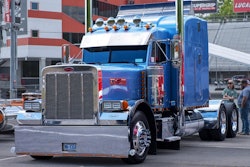
As the Trump administration launched deregulatory efforts, trucking interests and individual owners and operators earmarked several areas for attention from the Federal Motor Carrier Safety Administration and other Department of Transportation agencies.
- Hours of service and the ELD mandate -- most cited by truckers of all stripes as in need of repeal or replacement, largely for HOS with a goal of greater flexibility for recording drive and rest periods.
- Speed limiters -- FMCSA has signaled intent to mandate some use of speed limiters, though Congressional pushback continues in the current session.
- Broker transparency -- Overdrive readers largely support FMCSA's late 2024 proposal to strengthen records-transparency regulations for brokers, yet opinions among brokers and large-fleet interests run counter.
- Automatic emergency braking -- with multiple DOT agencies at work fulfilling Congressional directive to move to require AEB tech on new commercial trucks, groups representing small fleets and operators argued for withdrawal of a current proposal.
Comments came in response to the DOT's public call for input on ID'ing existing regs, guidance and/or other federally required processes/paperwork to streamline compliance for business and enhance safety. The comment period closed this week with only 900 comments, many of which came from within trucking.
[Related: What truckers want Trump and Elon Musk's DOGE to tackle in trucking]
Hours of service
Various aspects of the hours-of-service rules were identified by commenters as needing change, including the 14-hour on-duty daily maximum, the 30-minute-break requirement, electronic logs and more.
“I run out of the 14-hour clock long before I run out of drive time,” said commenter Leonel Beltier. “Due to the time used up while waiting to load and loading (time which I'm in the sleeper), the 14-hour clock causes me to drive as fast as I can to get as far as I can in the 6 to 8 hours I have of actual drive time.”
Beltier added that more flexibility should be added to allow short-distance moves during the 10-hour off-duty period. “Sometimes I need to move out of another truck's way, especially a wide load. It should be allowed to move a truck a short distance or time without being penalized,” he said. “Taking a few seconds to move my truck a short distance should not cause me to restart my 10-hour reset.”

[Related: Are you Roadcheck-ready? Inspectors to key in on PC, false logs]
Robert Hall called the 14-hour rule the “most dangerous” on the books. “It forces us to work when we are tired because we can't stop the clock when we need or want to,” he said.
Hall advocated for keeping the ELD mandate in place but to “do away with the 14-hour rule and split breaks for solo drivers. Make solos take all 10 hours at one time. Doing away with the 14-hour rule will let us stop and rest when we need to and still allow us to drive all 11 hours if we need to.”
Sean Hamilton, who said he has 30 years of experience in trucking, said his “main concern is when the logs went from 10 on and 8 off, to 11 on and 10 off. The original log system may have been paper, but the principle was sound. There weren't people making a mad dash to the truck stops because they had to be parked before 8 p.m. (filling all the truck stops to capacity before it gets dark), parking on shoulders because there isn't any other place to park.”
Hamilton called the 30-minute-break requirement a "good idea,” but said it has had adverse effects by causing accidents. “People are pulling into busy shoulders to take mandatory breaks, in turn getting rear-ended by distracted drivers or causing backups in traffic from traffic slowing to safely get around the parked trucks.”
Commenter Eric Moyer called for the 30-minute break to be removed completely because it “does nothing for safety and actually puts another burden on the driver. Most drivers are taking that time blocking the fuel islands, which increases anger with the drivers, making them rush more when they do get back on the road.”
Allowing more split-sleeper flexibility, Hamilton added, would help alleviate some of these issues. “If you go back to the ability to divide up your sleep time to 4- or 6-hour blocks and allow driving time to be divided up the same way, the roadways would be less congested during peak travel (truckers don't like getting stuck in traffic, because we get paid by the mile) so we would make an effort to travel after morning and evening rush hour traffic congestion.”
[Related: Significant hours-of-service change: FMCSA's 2020 split-sleeper provision changes, explained]
Joshua Thomas said he believes hours-of-service rules “should be in place to protect company drivers,” but advocated for owner-operators to “have a pathway to exemption, [whether] based on safety score/driving record or other factors.”
Among trucking industry organizations, it's significant that many, including the American Trucking Associations, argued for various measures of greater flexibility than what's allowed today. The Owner-Operator Independent Drivers Association called the HOS regulations “overly complex,” adding that they “provide little flexibility, and in no way reflect the physical capabilities or limitations of individual drivers.”
Similarly, the National Tank Truck Carriers (NTTC) group called HOS regs “overly complex and burdensome, particularly due to the numerous exceptions and the mandatory use of electronic logging devices.”
OOIDA highlighted that it has advocated for allowing truckers to pause their 14-hour clock with one off-duty period of no less than 30 minutes and no more than 3 hours, providing drivers with “greater flexibility to rest when they’re tired and avoid factors that make driving unsafe. A Split Duty Period would not increase maximum driving time, maximum on-duty time, or decrease minimum off-duty rest periods between shifts.”
OOIDA also called for more split-sleeper flexibility to also include 6/4 and 5/5 splits in addition to the current 8/2 and 7/3 splits allowed.
On the subject of ELDs, OOIDA said there is no evidence to suggest that ELDs have accomplished the intended goals of reducing fatigue-related crashes. “As a result of the mandate, small businesses have been forced to bear the majority of the $1.8 billion price tag associated with the installation of these devices,” the organization said in its comments. “For owner-operators, these costs have led to less investment in maintenance, equipment, and other critical safety upgrades.”
[Related: ELDs and highway safety: Crashes, injuries, fatalities rise post-mandate]
OOIDA called on DOT to repeal the ELD mandate or, “at the very least, we urge the Department to exempt small carriers with a proven safety record from being forced to invest their capital on these unnecessary devices.”
The organization added that if kept in place, ELD rules should be modified to “address persistent malfunctioning devices and cybersecurity gaps,” including FMCSA implementing “an independent certification process rather than relying on self-certification from manufacturers.”
NTTC said its tanker-pulling members struggle with the ELD mandate because they “may only undergo a roadside inspection once a year or even less frequently,” thus may not know how to properly transfer their logs to inspectors during roadside inspections. “As a result, motor carriers can accumulate significant HOS violations ... not because of unsafe driving or willful noncompliance, but due to procedural misunderstandings or unfamiliarity with ELD transfer protocols.”
The ATA urged FMCSA to focus efforts on "evaluating targeted HOS flexibilities -- supported by empirical data -- to ensure the rule set is adaptive without undermining core safety protections and is grounded in scientific research on fatigue, rest, and recovery.” The motor carrier association drew a line in the sand on ELDs, urging FMCSA “to reject any effort to unwind or weaken the ELD mandate.”
ATA said it supports pilot programs to evaluate the benefits of allowing more flexibility within the HOS regs.
The group also advocated for the removal of the requirements that drivers keep paper logbook backup pages in case an ELD malfunctions and that drivers keep physical copies of ELD instructions in their trucks.
[Related: 'Revert to paper logs': FMCSA revokes certification of 4 ELDs]
Speed limiters
FMCSA in 2022 revived work toward requiring that certain trucks’ speed be governed to a yet-to-be-determined speed. Several commenters took the opportunity to ask the DOT to abandon the work put into a speed limiter proposal.
“Get rid of the FMCSA speed limiter mandate proposal,” said Edward Vazemiller. “It is unsafe for semi trucks. … Speed limiters on semi trucks will cause more road raging, shootings, traffic, bumper-to-bumper traffic. Rear-end collisions and more accidents overall.”
OOIDA said that it “believes that withdrawing this proposed mandate would be an ideal way to achieve meaningful burden reduction while ensuring the safety of the U.S. transportation system.”
The National Association of Small Trucking Companies (NASTC) noted that such a mandate “would contribute to traffic density, putting more vehicles in close proximity on long stretches of our highest-speed roads.” This could “cause private motorists to become more impatient and take greater risks that result in more accidents,” the group added, illustrating one of Vazemiller's points above.
[Related: What’s going on with speed limiters and other trucking legislation?]
As it's previously argued, OOIDA said a speed limiter mandate “would create dangerous speed differentials" between commercial trucks and road users. "Decades of highway research show greater speed differentials increase interactions between truck drivers and other road users, and studies have consistently demonstrated that increasing interactions between vehicles directly increases the likelihood of crashes”
Broker transparency
Significant division among big transportation groups was on offer on the docket with respect to brokered-freight transaction transparency. With support for FMCSA's 2024 "broker transparency" proposal among owner-operators as wide and strong as it's been, OOIDA used the opportunity to advocate for FMCSA to finalize its changes. The 2024 proposal was to increase brokered-freight transaction transparency to give motor carriers better access to more information about any load to which they're a party, include a full record of any and all freight payments. That would include how much a shipper is paying the broker.
“We believe the proposal will help ensure carriers finally have access to transaction documentation,” OOIDA said, adding, however, that the proposal didn’t include all of the provisions OOIDA had petitioned for. “If supplemented properly, this rulemaking will contribute to a more ethical, fair, and efficient freight brokerage marketplace.”
[Related: Trucking attorneys: Broker transparency needed to fight fraud]
The Transportation Intermediaries Association representing brokers called not only for a withdrawal of the transparency proposal from last year, but an outright repeal of the existing broker transparency regulations in 49 CFR 371.3(c). “This regulation is an outdated relic that no longer serves a meaningful policy purpose,” TIA said. “It provides no clear benefit to the supply chain while serving as a launching pad for policies aimed at limiting competition, innovation and re-regulation.”
Of the 2024 transparency proposal, TIA said mandating transparency as proposed “undermines competition and market efficiency, exposing confidential business data and associated strategies that drive innovation.”
Instead, TIA advocates that FMCSA “should focus its efforts on addressing highway safety and addressing the proliferating fraud pandemic in the supply chain, which is costing the U.S. economy over $35 billion annually.”
ATA echoed TIA’s comments, recommending that FMCSA rescind the 2024 transparency proposal, as it would impose “unnecessary regulatory obligations that duplicate and interfere with contracting norms, conflict with the free-market structure of the freight brokerage industry, and fall well outside FMCSA’s safety mandate.”
The group also advocated for a full-on repeal of 371.3(c). “There is no demonstrated safety rationale or regulatory necessity for 49 CFR 371.3(c) or its expansion,” the group said.
[Related: TQL sued over transparency, contract waivers FMCSA told the broker to drop]
Automatic emergency braking
Groups representing truck drivers largely advocated for scuttling a notice of proposed rulemaking that would mandate automatic emergency braking (AEB) systems on heavy-duty trucks.
OOIDA said the joint rulemaking between FMCSA and the National Highway Traffic Safety Administration “mandates AEB systems without sufficiently addressing false activations, properly consulting with professional truck drivers, or completing ongoing research programs.”
The group said the DOT agencies “should listen to truckers and take all the time necessary to address the shortcomings of these systems. Truckers are not opposed to a technology that will help improve their safety and the safety of other motorists. But until the agencies can offer assurances this rulemaking can meet its desired safety objectives, they should not set forth any mandate.”
[Related: Are FMCSA and NHTSA skirting Congressional directive with AEB proposal?]
NASTC detailed what it's heard from members about the technology. “This burdens small business because we know from drivers’ experience with AEBs that these features put the lives and safety of truck drivers and the people in vehicles near them at risk every day,” NASTC said. “AEBs frequently suddenly slam on a truck’s brakes, catching the truck driver by surprise. The suddenness of the device’s action causes near-misses on our highways and may require evasive action on the professional driver’s part.”
Truck manufacturers also weighed in on FMCSA and NHTSA’s AEB proposal. International Motors called the proposal “perhaps the most consequential pending regulatory matter that USDOT is developing for the commercial vehicle sector.”
International added that the scope of the rule, covering all trucks with a GVWR over 10,000 pounds, “is a clear example of regulatory overreach beyond the authority Congress explicated in the Bipartisan Infrastructure Law.” The company detailed how it believes the agencies failed to follow Congress’ directive “and did not seriously consider how that would negatively affect this rulemaking and its outcome.”
Daimler Truck advocated for DOT refocusing the rule on just Class 7-8, electronic stability control-mandated tractors, and a separate effort “conducting further appropriate research, development, and validation activities for vocational vehicles. A two-track solution presents an opportunity to create a streamlined version of the proposed regulation before it goes into place, while minimizing the potential for unintended safety consequences.”
The Truck & Engine Manufacturers Association (EMA) referred back to its original comments on the AEB proposal submitted in 2023. “NHTSA should consider our proposed data-based and implementable strategy to greatly reduce the regulatory burdens on manufacturers and the U.S. trucking industry while maximizing the safety benefits of heavy vehicle AEB,” EMA added.
ATA told DOT that “deregulatory efforts should not hinder the advancement of Advanced Driver Assistant Systems (ADAS),” highlighting AEBs in particular. “ATA recognizes that AEB is a life-saving technology and many of ATA’s members have already adopted AEB into their fleets with positive results.”
[Related: AEBs ready for prime time? False-positive reports cast doubt]













